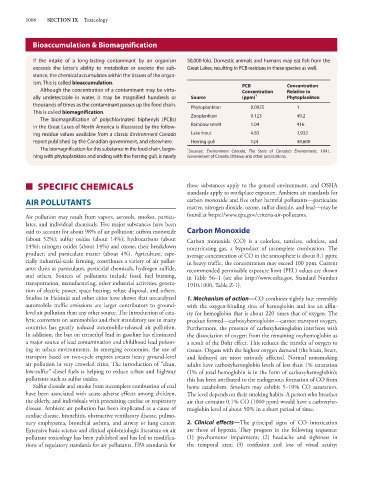Page 1020 - Basic _ Clinical Pharmacology ( PDFDrive )
P. 1020
1006 SECTION IX Toxicology
Bioaccumulation & Biomagnification
If the intake of a long-lasting contaminant by an organism 50,000-fold. Domestic animals and humans may eat fish from the
exceeds the latter's ability to metabolize or excrete the sub- Great Lakes, resulting in PCB residues in these species as well.
stance, the chemical accumulates within the tissues of the organ-
ism. This is called bioaccumulation. PCB Concentration
Although the concentration of a contaminant may be virtu- Concentration Relative to
ally undetectable in water, it may be magnified hundreds or Source (ppm) 1 Phytoplankton
thousands of times as the contaminant passes up the food chain. Phytoplankton 0.0025 1
This is called biomagnification.
The biomagnification of polychlorinated biphenyls (PCBs) Zooplankton 0.123 49.2
in the Great Lakes of North America is illustrated by the follow- Rainbow smelt 1.04 416
ing residue values available from a classic Environment Canada Lake trout 4.83 1,932
report published by the Canadian government, and elsewhere. Herring gull 124 49,600
The biomagnification for this substance in the food chain, begin- 1 Sources: Environment Canada, The State of Canada's Environment, 1991,
ning with phytoplankton and ending with the herring gull, is nearly Government of Canada, Ottawa; and other publications.
■ SPECIFIC CHEMICALS these substances apply to the general environment, and OSHA
standards apply to workplace exposure. Ambient air standards for
AIR POLLUTANTS carbon monoxide and five other harmful pollutants—particulate
matter, nitrogen dioxide, ozone, sulfur dioxide, and lead—may be
Air pollution may result from vapors, aerosols, smokes, particu- found at https://www.epa.gov/criteria-air-pollutants.
lates, and individual chemicals. Five major substances have been
said to account for about 98% of air pollution: carbon monoxide Carbon Monoxide
(about 52%); sulfur oxides (about 14%); hydrocarbons (about Carbon monoxide (CO) is a colorless, tasteless, odorless, and
14%); nitrogen oxides (about 14%) and ozone, their breakdown nonirritating gas, a byproduct of incomplete combustion. The
product; and particulate matter (about 4%). Agriculture, espe- average concentration of CO in the atmosphere is about 0.1 ppm;
cially industrial-scale farming, contributes a variety of air pollut- in heavy traffic, the concentration may exceed 100 ppm. Current
ants: dusts as particulates, pesticidal chemicals, hydrogen sulfide, recommended permissible exposure limit (PEL) values are shown
and others. Sources of pollutants include fossil fuel burning, in Table 56–1 (see also http://www.osha.gov, Standard Number
transportation, manufacturing, other industrial activities, genera- 1910.1000, Table Z-1).
tion of electric power, space heating, refuse disposal, and others.
Studies in Helsinki and other cities have shown that uncatalyzed 1. Mechanism of action—CO combines tightly but reversibly
automobile traffic emissions are larger contributors to ground- with the oxygen-binding sites of hemoglobin and has an affin-
level air pollution than any other source. The introduction of cata- ity for hemoglobin that is about 220 times that of oxygen. The
lytic converters on automobiles and their mandatory use in many product formed—carboxyhemoglobin—cannot transport oxygen.
countries has greatly reduced automobile-released air pollution. Furthermore, the presence of carboxyhemoglobin interferes with
In addition, the ban on tetraethyl lead in gasoline has eliminated the dissociation of oxygen from the remaining oxyhemoglobin as
a major source of lead contamination and childhood lead poison- a result of the Bohr effect. This reduces the transfer of oxygen to
ing in urban environments. In emerging economies, the use of tissues. Organs with the highest oxygen demand (the brain, heart,
transport based on two-cycle engines creates heavy ground-level and kidneys) are most seriously affected. Normal nonsmoking
air pollution in very crowded cities. The introduction of “clean, adults have carboxyhemoglobin levels of less than 1% saturation
low-sulfur” diesel fuels is helping to reduce urban and highway (1% of total hemoglobin is in the form of carboxyhemoglobin);
pollutants such as sulfur oxides. this has been attributed to the endogenous formation of CO from
Sulfur dioxide and smoke from incomplete combustion of coal heme catabolism. Smokers may exhibit 5–10% CO saturation.
have been associated with acute adverse effects among children, The level depends on their smoking habits. A person who breathes
the elderly, and individuals with preexisting cardiac or respiratory air that contains 0.1% CO (1000 ppm) would have a carboxyhe-
disease. Ambient air pollution has been implicated as a cause of moglobin level of about 50% in a short period of time.
cardiac disease, bronchitis, obstructive ventilatory disease, pulmo-
nary emphysema, bronchial asthma, and airway or lung cancer. 2. Clinical effects—The principal signs of CO intoxication
Extensive basic science and clinical epidemiologic literature on air are those of hypoxia. They progress in the following sequence:
pollutant toxicology has been published and has led to modifica- (1) psychomotor impairment; (2) headache and tightness in
tions of regulatory standards for air pollutants. EPA standards for the temporal area; (3) confusion and loss of visual acuity;

